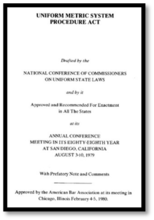Metrication in Law

Policy | Federal Government | State Government
Policy
The U.S. Congress has established a national policy of increasing the voluntary use of the metric system as the preferred system of measurement for trade and commerce in the United States. It is this national policy that places the decision and pace of metric use in the hands of individual companies, organizations, and persons. Currently, U.S. law permits the use of either the SI (International System of Units) or the U.S. customary measurement system. Although NIST is a non-regulatory agency, the adoption of SI practices is encouraged whenever possible.
Metric Policy in the United States has had an extensive history. The Metric Act of 1866 legalized the use of the metric system in America. Although many believe the United States does not use the metric system, Congress declared the metric system to be the preferred system of weights and measures for trade and commerce in 1988 with the Omnibus Trade and Competitiveness Act amendment to the Metric Conversion Act of 1975. Additionally, this act required federal agencies to implement metric measures wherever feasible. Current customary measurement units are defined by the SI; mass, length, and volume have been defined by metric units since the Mendenhall Order of 1893.
Federal Government Metrication Resources
Metrication resources for federal agencies are available to support the implementation of the 1991 Presidential Executive Order (EO) 12770, Metric Usage in Federal Government Programs. Federal agencies have been directed to use SI by the Presidential Executive Order (EO) 12770 and the Metric Conversion Act. Federal agencies share both SI implementation successes and barriers through the annual metric progress reports process. Report guidelines, sample agency reports, metric directives, and other implementation examples are available.
State Government Metrication Resources
The development of uniform state model laws, regulations, and codes is an effective way to promulgate new or revised metrication procedures throughout the states. Example organizations that collaborate with state governments include:
- National Council on Weights and Measures (NCWM)
- National Geodetic Survey (NGS)
- International Code Council (ICC)

The National Conference of Commissioners on Uniform State Laws (1980) published a model law, known as the Uniform Metric System Procedure Act (UMSPA), approved by the American Bar Association, that any state can use to establish a plan to create a metric transition infrastructure for managing the state government metrication process. The UMSPA was intended to supply a uniform structural mechanism for the 50 states to amend laws and regulations on a coordinated and timely basis in response to voluntary conversion activity. This document proposes a systematic approach for modifying references in legal state documents and implementing metric policy in program operations.
The Model proposes the creation of an Interagency Metric Council that would facilitate the following activities:
- Plan and coordinate activities among all state agencies. Evaluate interoperability amongst programs and data exchange systems where measurements are used.
- Actively seek business and consumer stakeholder input during the process.
- Analyze state industrial sectors to strategically identify those currently using metric practices and those that are not.
- Prioritize industrial sectors in an appropriate sequence to minimize costs and provide an opportunity to characterize and integrate “lessons learned” before progressing to subsequent sectors.
- Recently Proposed Legislation
- Hawaii
- Oregon
- Senate Bill 166 (2015)
Explore Metrication Resources
- U.S. Metrication
- Metrication Best Practices
- Metrication Costs and Benefits
- Metrication Case Studies
- Errors and Mishaps
- Education Metrication
- Metrication Training
- Metrication Resources for Researchers
Disclaimer: Any mention of commercial products within NIST web pages is for information only; it does not imply recommendation or endorsement by NIST.

